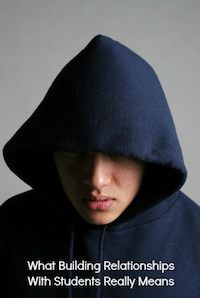What Building Relationships With Students Really Means
 It’s common for teachers to misunderstand the term “building relationships.”
It’s common for teachers to misunderstand the term “building relationships.”
They hear of the importance of creating connections with students—particularly difficult students—and assume it means they need to spend more time with them individually.
They assume it means they need to try and get to know them on a more personal level.
But for a real-world teacher, finding the time to build relationships in this manner is not only unrealistic, but it’s also ineffective. In fact, seeking out individual students in an attempt to earn their trust and rapport can do more harm than good.
You see, for most students, being cornered into a non-academic conversation with their teacher is uncomfortable—exceedingly so. It can make them feel clumsy and self-conscious and at a loss of anything to say.
Even the most socially confident students will feel unnerved and wary of your motives. And yet, there are teachers who day after day insist on pressing the issue.
They beckon students out of line, into hallways, and away from the social safety of fellow classmates. They barge into personal space. They query likes and dislikes and commonalities. They become forward and overbearing.
Although their heart is in the right place, what develops is a relationship of awkwardness and embarrassment. What develops is defensiveness and detachment. What develops builds walls instead of tearing them down.
But the goal of building relationships with students isn’t familiarity. It’s influence. And influence comes about not by one-on-one interactions, not by getting to know a student’s favorite ice cream or video game, and not by being hip to current pop-cultural trends.
No, influential relationships come about through your trust and likability.
If your students trust you because you always do what you say will, and they like you because you’re consistently pleasant, then powerful, behavior-influencing rapport will happen naturally and without you having to work at it.
Your students will seek you out and want to be around you and get to know you better. They’ll be drawn to you and pulled effortlessly into your circle of influence.
Your conversations and interactions then become open and easy. When you sit down to lunch with groups of students or meet them in their line before school, the give-and-take flows smoothly, organically. Nothing is forced. Nothing is inauthentic.
Even quiet and shy students—especially quiet and shy students—will come out of the woodwork to laugh and joke with you and exchange goofy smiles. This in turn gives you remarkable leverage to influence behavior, work habits, and enthusiasm for being part of your classroom.
So stop buying into the notion that you have to build relationships one student at a time. Stop thinking that you have to add yet another time-consuming strategy to your overflowing plate. Stop spending more time with some students and not others.
The fact is, the most effective way to build relationships with students also happens to be the most effective approach to classroom management.
Be true to your word. Follow through with your classroom management plan. Refrain from any and all harmful, scolding, bribing, manipulative, or friction-creating methods of managing behavior.
Smile. Love your students. Bring humor and joy to your classroom. And you’ll never, ever have to try to build influential relationships.

No comments:
Post a Comment